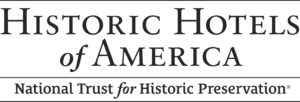History of the Penn Wells Hotel
Learn the story behind our historic hotel
The Historic Penn Wells Hotel has welcomed visitors to Wellsboro for more than 150 years. The Hotel was constructed in 1869 and opened in 1870 as the Cone House. Initially guests were primarily engaged in commercial pursuits, staying in the Hotel for short stints after arriving by rail or coach, and some taking residence at the Hotel for longer periods as they worked in local industries. With its rebirth as the Penn Wells Hotel in 1926, the Hotel welcomed an increasing number of leisure travelers to the area.
Today, the Hotel is a member of the Historic Hotels of America, offering a well-preserved example of architecture from both its 1869 construction and its 1920s era interior finishings, as well as numerous historical items of note, such as the glass bulb American flag that adorns one wall in its elegant lobby and the black and white photos that line the dining room walls.

1800’s
Benjamin Wister Morris, an agent of the Pine Creek Land Company, first came to Tioga County, Pennsylvania, from Philadelphia in 1805 with his wife, Mary Wells Morris, and their two children, Samuel and Rebecca. When they constructed their simple log cabin home, it was the only dwelling in what is now the borough of Wellsboro. Just one year later, with the Morrises still the only family living in the area, Wellsboro—apparently named for Benjamin’s wife—was designated as the county seat, through the agency of the Pine Creek Land Company.
Wellsboro’s location at the intersection of the Morris State Road (Rt. 287) and the East and West State Road (Rt. 6) made it a prime thoroughfare even in the early 1800s, and so Wellsboro’s first tavern was built in 1816 on the site of the present Penn Wells Hotel when Alpheus Cheney, the first sheriff of Tioga County, purchased the land from Samuel Morris. Since the construction of that first tavern, the site has always been occupied by a tavern, inn, or hotel.
Albert Pitkin “A.P.” Cone was a lawyer, born in New Hampshire, who relocated and settled in the Elkland and Lawrenceville areas before establishing a legal practice and real estate interests in Wellsboro. In 1850, he married Anna Bache, whose deceased father William Bache had been one of Wellsboro’s most prominent early settlers and its first merchant. Hobart Graves had operated the United States House on the site of the Penn Wells Hotel until it burned in 1866. Cone purchased the property from Graves’s estate, and it was vacant until April 1869, when at the age of 49, he began his now famous construction of our Hotel, a prominent landmark then and now.
After Cone’s death, the Hotel was sold to B.B. Holiday in 1873 and briefly went by “Holiday Inn” with Mr. Holiday keeping the hotel himself with Maj. Field running the dining room. The Hotel was sold next to Joel Parkhurst who renamed the Hotel Parkhurst House, which was run by Thomas Veazie via lease as landlord until 1883. The Hotel was renamed the Coles House on April 27, 1885 when J.S. Coles purchased an interest in the Parkhurst House and took over its operation. Coles had previously operated another property under the Coles House name but that Hotel had burned. J.S. ran the hotel with the help of his brother William Riley Coles who took over operations in 1893 when J.S. Coles fell ill. In 1896, J.S. Coles passed away turning the operation of the hotel over to his brother William Riley Coles, who became full owner of the Hotel and made major renovations to the Hotel including painting the Hotel woodwork red, refacing the original brick, adding a steel ceiling in the dining room, placing a tin roof on the Hotel’s notoriously leaky roof, and opening a new barroom.
Early 1900’s
On a cold March morning in 1906, with temperatures reading 10 below zero, a major fire struck the Hotel. At 6:15 a.m. the cupola collapsed followed by the roof at 6:45. The fire did not come under control until 8:30 on that morning. No guests were injured due to the containment of the fire to the third and fourth floor, but those 2 stories were gutted by the fire and the top floor had to be removed.
Coles continued to operate the 3 story Penn Wells Hotel for an additional 14 years until his death in 1920. In 1921 Clark B. Richardson, a Galeton hotelier, purchased the Coles House property from the estate of William Riley Coles and changed the name of the property to the Wellsboro Inn. Richardson intended to make improvements but those did not come to pass, and the Wellsboro Inn closed on October 23, 1925.
In response to the declining success of the Wellsboro Inn, on May 1, 1925 in a meeting held at Tyoga Country Club, the Wellsboro Hotel Company was formed by 60 local community members to purchase the property. Notable figures at the meeting included Leonard Harrison, who would personally buy 1/6 of the subscription of shares and bonds issued to support the Hotel’s renewal, Roy Dunham, former Congressman Horace Packer, and Claude E. Bennett, President of Tioga Savings & Trust, who would serve as the first Wellsboro Hotel Company President. What followed by a complete renovation of the Hotel, which would be renamed the Penn Wells Hotel. While the walls, floors, and some partitions were kept, most of the Penn Wells was new. New floors were laid on top of the old floors. A new water system with brass pipe was added with a thermo circulation system that – at that time – was considered state of the art for its ability to keep hot water present throughout the building. A heating system of steam air was installed. The reconstructed Penn Wells contained 55 guest rooms, 42 containing private baths, as well as two public baths, one on each of the guest room floors. The bathrooms included tile wainscoating and ventilating air shafts leading up to the roof.
1920’s and 1930’s
The Hotel flourished throughout the rest of the 1920s and 30s, even in the face of the Great Depression. A reporter for the Philadelphia Inquirer called it “the gem of the Roosevelt Highway,” and the Penn Wells was known as one of the classiest hotels with the best service and amenities in Pennsylvania. It became a destination, as opposed to a stopping point on the way through untamed northern Pennsylvania. A regular bus service ran from New York’s Waldorf-Astoria to the Hotel in the late 20s, bringing Groucho Marx to stay at the Hotel in 1928. Buses made special trips from Philadelphia and Pittsburgh, and even the B&O Railroad ran a special excursion from Pittsburgh. The Penn Wells was also a popular stop along the Greyhound bus route from New York to Chicago.
Adding to the Hotel’s success, the Arcadia Theatre, which was built in 1921, showed its first “talkie” in 1929, making Wellsboro the first small town north of the Mason-Dixon Line to show talking pictures. The Theatre would later hit a major milestone in 1949, when it hosted the world premiere of Top O’ the Morning starring Bing Crosby.
In 1931, in the midst of the area’s first natural gas boom, the Penn Wells built the “new” section of the Hotel, which added 18 additional rooms (those ending in 29-34) and enlarged the dining room to accommodate the influx of people to the area.
WWII
During WWII the Hotel served as a community gathering place, hosting Saturday evening Hoedowns, concerts, and various dinner events and meetings. Corning Glass works held their annual holiday party in 1946 and presented the Hotel with the American flag constructed of 1,438 glass Christmas ornaments that now hangs in the Hotel’s lobby. One distinguished guest of this era was Joan Crawford, who stayed at the Hotel in 1943, when she came to see the Pennsylvania Grand Canyon. The Penn Wells also took on patriotic duties, housing the Ladies Room, where local women sewed clothes for the needy, and an observation post on the roof, built for detecting enemy aircraft.



